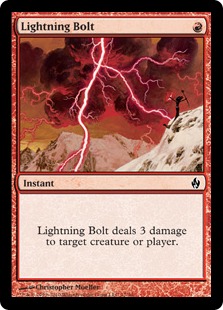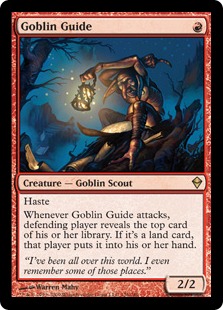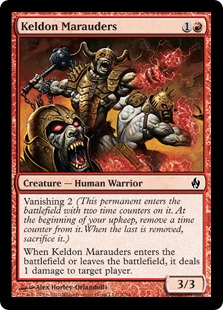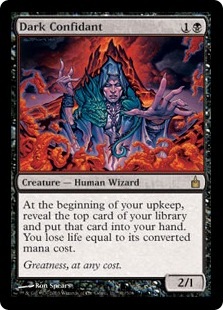
Hello and welcome again to Squandered Resources. First off, I would like to apologize for the hiatus. It took me much longer to write this article than it should have. I can try to justify the delay with excuses like the emergence of the Modern format, college, and moving to a new apartment all hoarding my attention. Admittedly, however, the delay should not have been this long. Regardless of the reasons, let's not delay this any longer!
Lightning Bolt!
Way back in December of 2005, a man named Brandon Boucher became infamous among the online community when a video featuring him in a kilt pretending to be a wizard hit YouTube. If you don't know the video, simply search the phrase "lightning bolt" on the video website and prepare for hilarity. Actually, scratch that. Search "lightning bolt special version" and watch that one, it's much better. Watch this video; learn well the technique this man uses. Soon enough you will be saying these words just as much, if not more, than Mr. Boucher as you fling atmospheric electrostatic discharges at the faces of everyone you meet.
Why did I show you this ridiculous video? If not at least mildly entertaining, it excels at its role of introducing my next budget deck to be discussed. Burn! Everybody knows it, not that many people play it and even fewer people think it's viable. I believe those doubters to be wrong. If lightning bolts can kill an eight-foot tall ogre than they should easily be able to fry the measly excuse for a human sitting across from you. In all seriousness, though, Burn is one of the most consistent and fun decks I have ever been able to play and I think it's about time you started playing it as well.
"Hold on!" You say. "Burn is infamous for being sub par! How can you justify playing it?" Well, for one, it's not as "sub par" as everyone thinks it is. The general perception of Burn is that it is the choice of someone who is new to the game of Magic, or doesn't know how the game works in general. Admittedly, that is a large part of the Burn player base. However, as long as you actually understand how to build Burn, how to play Burn, and the fact that there's a lot more going on here than arbitrarily throwing Lightning Bolts at your opponent's face, there are many reasons to play the deck. Patrick Sullivan, a man who many see as the premiere Burn player, said it quite well when he said...
"Since the deck is usually selected by, shall we say, a lower quality of magician, and people play with poor lists, the deck can usually be found in the back of the room, away from the top tables. I know we can do better."

Fast-forward to today. When was the last time you saw a Rhox War Monk? What about a deck with Counterbalance and Sensei's Divining Top used together in the main board? Unless your meta is stuck in 2009-10 it's been a while, I'm sure. Due in large part to Mental Misstep the format both slowed down greatly and lost the vast majority of all Counterbalanc- based decks, and it hasn't fully sprung back yet. It is because of both the absence of Counterbalance and Rhox War Monk, as well as the slower pace of the format in general, that Burn decks can... well... burn.
So that we may better understand why the deck is not as bad as people think, let us tackle each of the factors that are generally accepted as the cause of the widespread negative view on Burn. First on the list is... the list!
The List Part A
After being asked to feature Burn in my next article by a number of you I decided to build it for myself and play in a few tournaments. If you need proof that the deck is indeed viable, look no further. I played Burn in five consecutive tournaments, each with at least 25 people, each in one of, if not the, most competitive and well developed metas in the region. How many of these tournaments do you think I placed in at least top eight? All of them? Good guess!
Here is the list I piloted for all five of the tournaments.
| DeckMagic OnlineOCTGN2ApprenticeBuy These Cards | |
|---|---|
|
Lands-19 17 Mountain 2 Barbarian Ring Creatures-12 4 Goblin Guide 4 Keldon Marauders 4 Hellspark Elemental Other Spells-29 4 Lightning Bolt 4 Chain Lightning 4 Rift Bolt 4 Lava Spike 4 Fireblast 4 Flame Rift 3 Price of Progress 2 Volcanic Fallout | Sideboard-15 4 Red Elemental Blast 4 Smash to Smithereens 3 Tormod's Crypt 3 Pyrostatic Pillar 1 Volcanic Fallout |
Cost with sideboard: $133
This article is very different than my previous in the sense that I am only presenting one list to discuss. The main reason behind this is that Burn is not as malleable as White Weenie as an archetype. Either you are playing the correct cards or you are not. What I really enjoy about this, though, is that it's very easy to figure out how much money you will be investing in the deck. Give or take the price of six cards, which are meta decisions and will probably be just as cheap as everything else, the deck will almost always cost the price that I have listed above. This price is unquestionably cheap, even compared to the lists I discussed in my previous article, and that is something that should excite you.
One of the main reasons Burn is seen as a bad deck is because people often play bad lists. Burn is meant to perform in a very specific way. If the cards you choose to run do not compliment this play style, they should not be played. You may notice that I do not play either Grim Lavamancer or Figure of Destiny. That is because most of the time they simply do not belong in the deck. Even if I do quote Patrick Sullivan and have an immense amount of respect for him and his skill as a player, it does not mean I have to agree with him on everything. I will even go so far as to say that when he made the choice to play these creatures back in March he was just plain wrong. Did I just call out Patrick Sullivan? Well, not exactly. In his defense he justified the use of both of these cards pretty well when asked about them. However, I still think he was wrong to play them, as the drawbacks of these cards outweigh the justifications he used.

This inevitable race is one of three major factors that decide what cards can and cannot be played in Burn. Grim Lavamancer is a creature card that in many ways causes you to lose this race. For one, he is a card that costs you one mana on the turn you cast him but does not do damage to your opponent in that same turn. When every single turn is the difference between a win and a loss that one mana means quite a lot. That is one mana that could have been spent on actually making your opponent 3 damage closer to losing. Also, Grim Lavamancer forces you to run fetch lands in order to consistently be able to use his Shock ability. These lands burn you for 1 damage every time you use them, causing you to lag behind in the damage race every time you want to create fuel for the mancer. A card that both slows down your kills and speeds up your opponent's is not what Burn wants.
The second major factor is something called "guaranteed damage." This ties in very well with the idea of the damage race. Aside from getting countered, guaranteed damage asks the question "will the spell I just spent mana on actually do damage?" If the answer is "no" or "I'm not sure," you just got yourself closer to losing the damage race. Keldon Marauders does damage the turn he comes into play, potentially hits for 3, and again pings your opponent for 1 when he dies. At the most he is 5 damage for two mana and at the least he is a blocker that also burns for 2 no matter what. This is the idea behind guaranteed damage and this is not Grim Lavamancer. Mancer does no guaranteed damage, as he must both survive until your upkeep and have fuel in order to do his Shock damage. He doesn't even trade with a Wild Nacatl.
The fact that Grim Lavamancer needs to survive through your opponent's turn is also a big part of the third and final factor of Burn card competence. VCA, or "Virtual Card Advantage," is most likely not a term you have heard before. This is okay, because not a lot of decks actually strive to use it on a game-to-game basis. On a basic level what this term means is that I may not have more cards than you, and they may not be more powerful than yours, but every single one of them is relevant. Burn should be constructed in a way that makes a large number of cards in your opponent's deck much worse, or simply worthless, because they are not relevant. By running so many Lightning Bolts, your opponent's counter spells are less relevant as there is no key spell for them to target. By running so few creatures, your opponent's removal is also made obsolete. This is where Lavamancer comes in. The second he hits the field he immediately makes every removal card in your opponent's deck usable. He is also a very relevant counterspell target, especially for decks like Merfolk. This makes him effectively destroy much of what the deck attempts to accomplish in the first place.
Figure of Destiny is more or less guilty of each of the things I mentioned discussing Lavamancer. Beyond this however, we have other issues. The overall goal of Burn is to kill your opponent with burn spells while maintaining tempo and VCA.Figure of Destiny is a card that assumes you are trying to produce some kind of board position. This is done by using a total of five mana to make a 4/4 creature that can be blocked or killed very easily. This is also something Burn wants nothing to do with. Every mana you sink into that Figure is mana that should be spent on spells that have guaranteed damage.

The List Part B
Burn is a meta decision, not only in a player's choice to play it but also in how a player constructs it. Most Burn decks are extremely air tight in terms of their main board. As far as interchangeable cards go, usually you will see somewhere between four to six slots in which meta-relevant cards can be inserted. These slots in my list are filled by Flame Rift and Volcanic Fallout.
Flame Rift is a very peculiar card. For two mana you get 4 damage to both you and your opponent. This means that it is very good in terms of how much it does compared to the investment you put into it. However, a Burn player must be very careful. As I said earlier, every game is a race and as the game goes on your opponent will inevitably gain a larger and larger board state. If you play an early Flame Rift and hit yourself for 4 there is a possibility that it may come back to bite you after your opponent gets a few creatures on board. This card should be used as a four-of in metas where it takes your opponent a little bit of time to gain a board, if any at all. If there are a lot of very aggressive strategies in your meta, like Zoo, then this may not be your best choice.
Volcanic Fallout is similar in the sense that it should only be used in certain metas. The meta I played in had many Elf, Merfolk, and Maverick decks, among other things. Volcanic Fallout was immensely powerful in these match-ups because it allowed me to control the board. Against the tribal decks I could hold control of the game before they themselves got out of control, all without having to worry about counter magic. Keeping lords of off the board is how you beat Merfolk and Fallout was that little extra push the deck needed in the match-up to ensure that I still had enough burn to kill my opponent even after burning away their lords.
When Maverick players play against Burn they know Umezawa's Jitte is a powerhouse. Normally their strategy is to swarm the field with as many creatures as possible so that you waste your burn spells on those. The idea being you are hoping to get rid of Jitte threats with your burn spells rather than using them on your opponent's dome. Fallout helps you control the number of creatures that can be equipped with Jitte just enough to allow you to actually hit your opponent.
Everything else in the list should be pretty self explanatory. Hellspark Elemental is basically un-counterable, so he's nice against control lists. The same can be said for Barbarian Ring, which can be the deciding factor in many control match-ups. The life loss it forces you to take is risky though, so the land shouldn't be used if there won't be any control match-ups.
Playing Burn
Now that we have discussed the cards that can be included in the list we can look some pointers on how to play Burn.
The most common misconception about in Burn is that piloting it is simply throwing every burn spell you get at your opponent with little thought about anything else. You can play it like this, sure, but not if you want to actually win. Every spell in Burn has its ups and downs, especially at different times in the match. Because of this there is a very specific order that each of the spells should be cast compared to the others.
The first card that should be played, no matter what, is Goblin Guide. A turn one Guide is guaranteed two damage that gives you valuable information and must be answered by your opponent then and there. Giving you hints as to the cards, and possibly deck, that your opponent is playing is a very powerful upside, especially in game one of the match. This allows you to make the correct play decisions later in the game based on what Guide shows you. Aside from this, playing Guide early means he has more of a chance to hit multiple times, based on when your opponent can set up blockers. The earlier he is played, the more value you get out of him.
If Goblin Guide is not in your opening hand then your first play should be Rift Bolt. Why? Beyond the fact that it takes a turn to actually do anything, and you want to keep tempo in the middle to late game, it allows you to potentially take care of an early threat without wasting another spell.
If neither Rift Bolt nor Guide is in your opening hand, then Lava Spike is next. Spike can only hit players, so it's best when it's played early because you want to save your Chain Lightnings and Lightning Bolts for potential creature threats that you must answer, like Lord of Atlantis or Stoneforge Mystic.
After this, if you have none of the previous cards, you are left with Chain Lightning and Lightning Bolt as your one-drops. Chain Lightning can be played right away, similarly to Lava Spike. Setting your land, then waiting and using Lightning Bolt at their end phase is an acceptable play, as it allows you to save it just in case they play an early threat you must answer.
Once you hit turn two you should have your second land drop. Wait to actually drop it, though. If Goblin Guide is on the field and you do not have a Hellspark Elemental in your hand, attack. Your opponent will be forced to guess whether or not you are missing a land drop, which can draw them into wasting a spell they normally would not use otherwise. After the attack you can set your land and continue the burn. If Hellspark is in your hand, however, play him to help the Guide.

If Guide is not on the field and you do not have a Marauders, then Hellspark is your play. He is best when he is not blocked, and can come back later in the game when you run out of gas or your opponent forgets about him.
Because the game is always a race, if you have no two-drop creatures, then Flame Rift should come down. The earlier you play this card, the less if hurts you. This is especially true in an aggro match-up because your opponent will have fewer threats on the board to use the double-edged sword damage to their advantage.
Once you hit turn three you should just continue these patterns. Attack with whatever is currently on the field then play any and all creatures. Follow up with your Bolts and the like to the dome. Hit any threats that must be answered with Chain Lightning or Lightning Bolt. By turn four or five you should be finishing your opponent with Price of Progress, Fireblast or both.
If you are playing against some kind of control deck and they are not dead on turn five you must completely change your game plan. This is a very unique match-up that I feel must be addressed. In this situation your game changes based on the clock they have you on. Stop playing burn spells. Play "draw-go" until you are facing down lethal damage. Barbarian Ring and Hellspark Elemental are key in this match-up because they are somewhat un-counterable. Once it's obvious that you must either kill your opponent this turn or die, go off with everything you have been saving up. Swarm them with burn spells. If it works out, you will have more burn spells than they can answer and you will get through the wall. This can be made more effective if you can get some instant speed damage on them before the start of your final turn.
The Future of Burn
There are two important events that have happened recently which may change the future of Burn dramatically. The first is the banning of Mental Misstep and the second is the printing of Bump in the Night.
With the banning of Misstep, the format is left wide open in terms of what people are going to start playing. There is a chance that Counterbalance decks will make a comeback, but I don't personally believe this will happen, at least not with any level of permanence. If one were to look at high-level tournament results in the months before the printing of Misstep, it would be seen that Counterbalance decks were dying well before the card was printed. Rather than being the reason for the death of the archetype the card was more or less the final nail in the coffin.
Of course, with Mental Misstep out of the picture we can assume that people will once again play everything they have bean yearning to play but could not. This includes Storm Combo variants, and where there is Storm, there is Counterbalance. Overall, it comes down to this: If a lot of people begin to play combo, then Counterbalance is likely to make a comeback. As a result of this comeback, Burn will not be as viable. However, if this happens, Counterbalance will likely only exist for as long as the combo decks exist. Once the meta shifts and Counterbalance leaves, waiting for the next surge of combo, Burn will there ready to strike. Alternatively, you can look at it like this: As long as your meta does not include Counterbalance, at least in threatening numbers, Burn will always be a strong option.
The situation that Bump in the Night presents us with is an interesting one. We now have twenty "Lightning Bolts" at our disposal, which is very exciting. In one hand, the card is an additional Lava Spike, which is extremely relevant, as the more Lightning Bolts we have, the more consistent and speedy the deck is. On the other hand, using the card would force the use of fetch lands and dual lands, which ping us for damage and leave us vulnerable to Wasteland, something Burn has never had to worry about before.
Splashing black gives Burn player many new toys for their sideboard as well. Forsaken Wastes is a very tasty looking alternative to Sulfuric Vortex, as it does not cost double colored mana and burns the opponent if they try to get rid of it. The downside being it does half the damage as Vortex every turn. Following these same lines, Rain of Gore could warrant some testing as well.Planar Void would be an interesting alternative graveyard hate card, as it is permanent, unlike Tormod's Crypt.

The future of Burn is something difficult to predict. Will counterbalance make a comeback? Do the risks of splashing black outweigh the benefits? Only time will tell. At the very least, many of these things warrant testing.
Comments